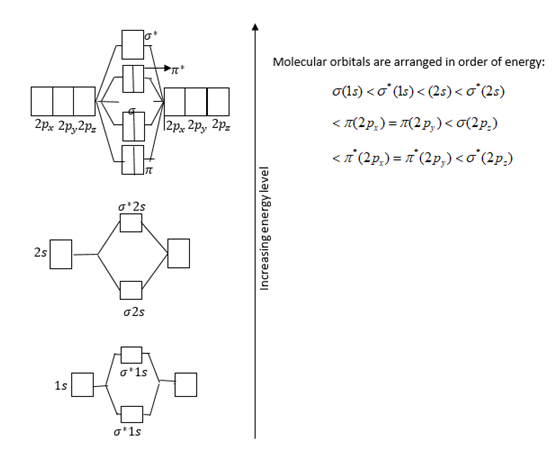
State magnetic properties of ${O_2}$ and ${N_2}.$
Answer
219.9k+ views
Hint: Magnetic property of molecule explains on the basis of molecular orbital theory that, there or two types of molecule i.e., diamagnetic and paramagnetic when atomic orbital contains unpaired electron, it is paramagnetic and if it contains paired electrons the molecule is diamagnetic.
Complete step by step answer:
Let us explain the formation of bonds on the basis of molecular orbital theory.
Nitrogen molecule $[{N_2}]$:
Electronic configuration of N-atom, $1{s^2}2{s^2}2p_x^12p_y^12p_z^1.$
Total number of electrons present in ${N_2}$-molecules is \[14,7\]from each N-atom.
Atomic orbitals of N-atoms form two types of orbitals i.e., bonding and antibonding.
Bonding molecular orbitals form the additive effect of atomic orbitals and antibonding forms subtractive effect of atomic orbital.
Atomic orbitals and relative energies of them are shown in figure.

Total electrons filled in orbitals are as follows:
$\sigma {(1s)^2}{\sigma ^*}{(1s)^2}\sigma {(2s)^2}{\sigma ^*}{(2s)^2}\pi {(2{p_x})^2}\pi {(2{p_y})^2}\sigma {(2{p_z})^2}$
Presence of no unpaired electron indicates that ${N_2}$molecule is diamagnetic in nature.
Bond order of ${N_2}$molecule is three, which means that ${N_2}$molecule contains triple bonds.
Bond order$ = \dfrac{{Nb - Na}}{2}$
$ = \dfrac{{8 - 2}}{2}$
Therefore, Bond order $ = 3.$
\[{N_b}\]= Bonding electron
${N_a}$= Antibonding electron
Formation of ${O_2}$ molecule:
Electronic configuration of O-atom is, $1{s^2}2{s^2}2p_x^22p_y^12p_z^1.$
Total number of electrons in the ${O_2}$ molecule is 16. 8 from each O-atom.
14 electrons fill the atomic orbital as has been done in case of ${N_2}$molecule.
The next orbital according to increasing energy ${\pi ^*}(2{p_y}){\pi ^*}(2{p_z})$which have equal energy.
Two more electrons added according to Hund’s Rule.
Therefore, each orbital has one electron.
$\sigma {(1s)^2}{\sigma ^*}{(1s)^2}\sigma {(2s)^2}{\sigma ^*}{(2s)^2}\sigma {(2{p_z})^2}\pi {(2{p_x})^2}\pi {(2{p_y})^2}{\pi ^*}{(2{p_x})^1}{\pi ^*}{(2{p_y})^1}$
Since $\pi $antibonding orbitals have one electron each i.e., unpaired electron.
Therefore, oxygen molecules are paramagnetic in nature.
Therefore, Bond order of ${O_2}$molecule$ = \dfrac{{{N_b} - {N_a}}}{2}$
$ = \dfrac{{8 - 4}}{2}$
Therefore, Bond order $ = 2.$
Therefore, oxygen molecules form double bonds between O-atoms.
Therefore, from the above explanation, the correct option is B
Note: According to molecular orbital theory. Atomic orbitals of combining atoms lose their individual identity. Paramagnetic nature of oxygen and no-existence of $H{e_2},N{e_2}$ molecule explained only by molecular orbital theory.
Complete step by step answer:
Let us explain the formation of bonds on the basis of molecular orbital theory.
Nitrogen molecule $[{N_2}]$:
Electronic configuration of N-atom, $1{s^2}2{s^2}2p_x^12p_y^12p_z^1.$
Total number of electrons present in ${N_2}$-molecules is \[14,7\]from each N-atom.
Atomic orbitals of N-atoms form two types of orbitals i.e., bonding and antibonding.
Bonding molecular orbitals form the additive effect of atomic orbitals and antibonding forms subtractive effect of atomic orbital.
Atomic orbitals and relative energies of them are shown in figure.

Total electrons filled in orbitals are as follows:
$\sigma {(1s)^2}{\sigma ^*}{(1s)^2}\sigma {(2s)^2}{\sigma ^*}{(2s)^2}\pi {(2{p_x})^2}\pi {(2{p_y})^2}\sigma {(2{p_z})^2}$
Presence of no unpaired electron indicates that ${N_2}$molecule is diamagnetic in nature.
Bond order of ${N_2}$molecule is three, which means that ${N_2}$molecule contains triple bonds.
Bond order$ = \dfrac{{Nb - Na}}{2}$
$ = \dfrac{{8 - 2}}{2}$
Therefore, Bond order $ = 3.$
\[{N_b}\]= Bonding electron
${N_a}$= Antibonding electron
Formation of ${O_2}$ molecule:
Electronic configuration of O-atom is, $1{s^2}2{s^2}2p_x^22p_y^12p_z^1.$
Total number of electrons in the ${O_2}$ molecule is 16. 8 from each O-atom.
14 electrons fill the atomic orbital as has been done in case of ${N_2}$molecule.
The next orbital according to increasing energy ${\pi ^*}(2{p_y}){\pi ^*}(2{p_z})$which have equal energy.
Two more electrons added according to Hund’s Rule.
Therefore, each orbital has one electron.
$\sigma {(1s)^2}{\sigma ^*}{(1s)^2}\sigma {(2s)^2}{\sigma ^*}{(2s)^2}\sigma {(2{p_z})^2}\pi {(2{p_x})^2}\pi {(2{p_y})^2}{\pi ^*}{(2{p_x})^1}{\pi ^*}{(2{p_y})^1}$
Since $\pi $antibonding orbitals have one electron each i.e., unpaired electron.
Therefore, oxygen molecules are paramagnetic in nature.
Therefore, Bond order of ${O_2}$molecule$ = \dfrac{{{N_b} - {N_a}}}{2}$
$ = \dfrac{{8 - 4}}{2}$
Therefore, Bond order $ = 2.$
Therefore, oxygen molecules form double bonds between O-atoms.
Therefore, from the above explanation, the correct option is B
Note: According to molecular orbital theory. Atomic orbitals of combining atoms lose their individual identity. Paramagnetic nature of oxygen and no-existence of $H{e_2},N{e_2}$ molecule explained only by molecular orbital theory.
Recently Updated Pages
Electricity and Magnetism Explained: Key Concepts & Applications

JEE Energetics Important Concepts and Tips for Exam Preparation

JEE Isolation, Preparation and Properties of Non-metals Important Concepts and Tips for Exam Preparation

JEE Main 2021 July 25 Shift 1 Question Paper with Answer Key

JEE Main 2021 July 22 Shift 2 Question Paper with Answer Key

States of Matter Chapter For JEE Main Chemistry

Trending doubts
Understanding Atomic Structure for Beginners

Understanding Centrifugal Force in Physics

JEE Main Marking Scheme 2026- Paper-Wise Marks Distribution and Negative Marking Details

Understanding Electromagnetic Waves and Their Importance

Understanding Entropy Changes in Different Processes

Common Ion Effect: Concept, Applications, and Problem-Solving

Other Pages
NCERT Solutions For Class 12 Chemistry Chapter 9 Amines

Understanding Excess Pressure Inside a Liquid Drop

Test for Phenolic Group

Understanding Geostationary and Geosynchronous Satellites

NCERT Solutions For Class 12 Chemistry Chapter 2 Chapter 2 Solutions Hindi Medium in Hindi - 2025-26

NCERT Solutions for Class 12 Chemistry Chapter 2 Electrochemistry




